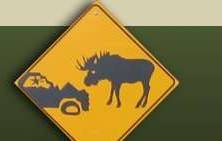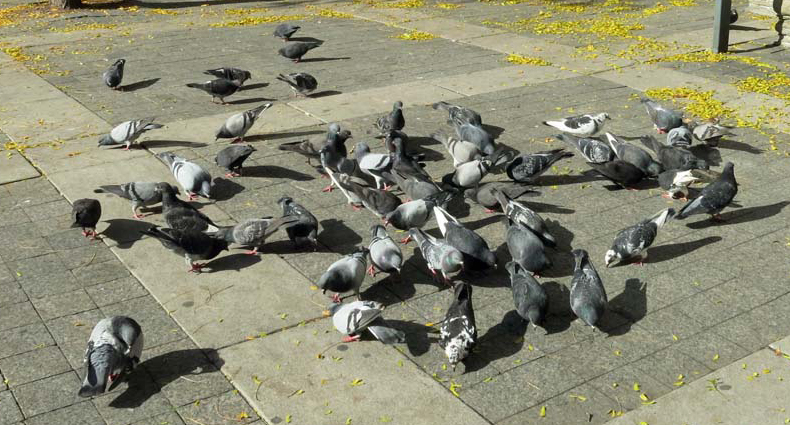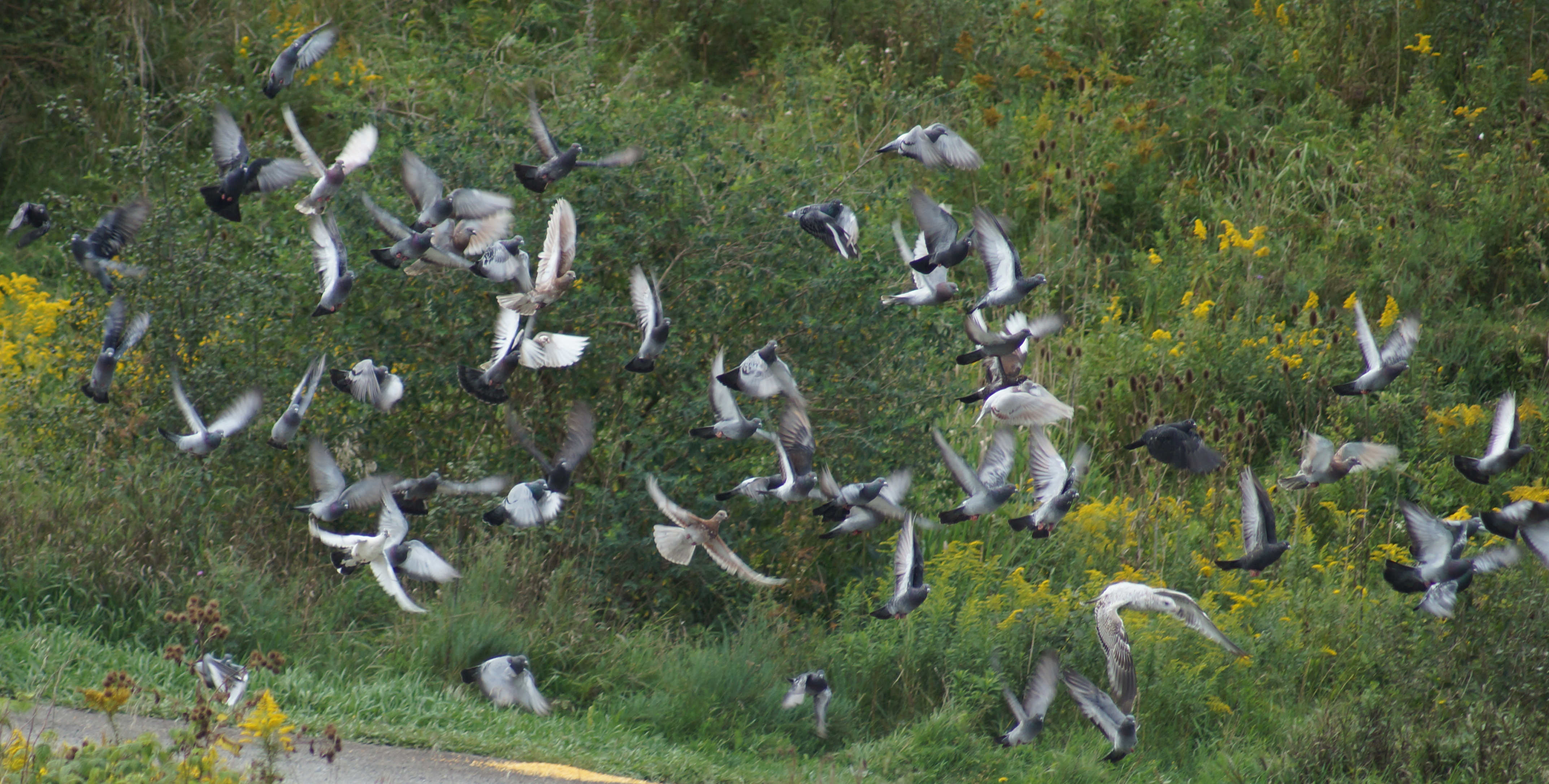
Ulli Diemer — Radical Digressions
Blogs & Notes
- Notebooks: 11 - 10 - 9 - 8 - 7 - 6 - 5 - 4 - 3 - 2 - 1
- Latest Post
- Moments
- Quotes & Fragments
- Scrapbook
- Twitter @ullidiemer
Articles Lists
- Selected Articles
- Articles in English
- Articles in French
- Articles in Spanish
- Articles in German
- Articles in Other Languages
- Articles A-Z
- Subject Index

Compilations & Resources
Pigeons and people
By Ulli Diemer
When I walk in downtown Toronto – something I do nearly every day – I find I spend a lot of time observing other pedestrians. That’s partly a matter of curiosity, because people never cease to fascinate me, but it’s also a matter of necessity, because the sidewalks and intersections are bustling with people, and you have to be alert to avoid bumping into each other.
What I find amazing is how well most of us perform our parts in the intricate ballet that takes place on a city sidewalk. In the busy times of day, which is when I’m usually out there, there can be hundreds of people in motion on a single block, heading in the same direction, heading in the opposite direction, criss-crossing the street, talking to people beside them, walking in and out of stores, hefting bags, musical instruments, and sports equipment, or coming to a sudden stop.
On top of that, many of them are looking at their phones, rather than at where they are going. That’s a bit imprecise, actually. Some of them are looking at the GPS on their phones, which may in fact tell them in which direction their destination lies, but unfortunately doesn’t tell them if someone is standing in front of them.
And yet it all works. We weave, dodge, zig-zag, move to one side or the other, slow down, speed up, and we nearly always do it without colliding.
We aren’t the only ones who manage this. Every self-respecting downtown, including Toronto’s, has pigeons, and pigeons have mastered the sidewalk ballet quite as expertly as we humans have. I try to vary my route to and from the office, but whichever route I take reliably features several spots where pigeons gather. These spots are invariably on a sidewalk or walkway. That’s where the food is. There is what might be called naturally occurring food, for example near the places where people eat, and drop, take-out food, and then there are locations where people come to feed the pigeons, and where the pigeons consequently come to be fed.
Many of those pigeon-feeding spots – Philosopher’s Walk and Queen’s Park North are two I am familiar with – are right on busy walkways. Not a problem, not for the pigeons, anyway. The pigeons are simply another kind of pedestrian, aware of, but not perturbed by, the steady stream of human pedestrians passing by. They’ll walk a few inches to one side or the other to avoid a human, or another pigeon, but that’s all. They rarely bother to take to the air, except when arriving or leaving as a flock, at which times they demonstrate their remarkable ability to stay close together without colliding: in three dimensions, not merely the two dimensions we humans have mastered.

I imagine an invisible extra-terrestrial observer studying the scene in Queen’s Park. We humans are of course very aware that we are human, and we think that makes us special. From an extraterrestrial’s point of view, however, that difference might not seem so significant. To them, the scene might appear as a considerable number of busy two-legged vertebrates, some bigger, some smaller, some with wings, some without, all engaged in Urban Pedestrian Behaviour, going about their mysterious two-legged business. Obviously, an observer would conclude, we belong together.
They would be right. For better or worse, it seems humans and pigeons do belong together. Our relationship began thousands of years ago, when wild rock doves nesting on cliffs somewhere in the Fertile Crescent or the Mediterranean region started to notice that those humans down there were gathering grain and spilling some of that grain near where they lived. Free food!
Eventually those human started to put up structures made of mud, wood, and stone. Free nesting sites close to the food!
The humans, for their part, learned that rock doves could easily be tamed if you took the young from the nests. They could then be induced to breed (not that much inducement is needed with rock doves) and some of the young they produced could be eaten. Free food! Free feathers!
We’ve been together ever since. When humans moved from tiny clusters of huts to villages, and then to towns, and then into cities, rock doves/pigeons moved right along with us. (“Pigeon” and “dove” are interchangeable terms used to refer to the same species of birds. Our common pigeons – Columba Livia – are known as rock doves or rock pigeons.)
Today pigeons are the quintessential city bird. In fact, pigeons (along with perhaps sparrows and starlings) may be the only birds that many people living in dense urban areas ever see.
Not everyone likes having them around. They gather and roost in large numbers, which some people find intimidating, and they produce copious quantities of droppings, which are not only gross if you’ve unwarily walked below a pigeon, but which can be a health hazard. Diseases associated with pigeon droppings include Cryptococcosis, Histoplasmosis and Psittacosis.
I recall an incident when my partner Miriam and I were on a bike ride which took us through St. Jamestown, a dense cluster of highrise buildings near Parliament and Wellesley. We dismounted our bicycles to check out the offerings of the street vendors who were clustered on the sidewalk near the supermarket. That’s when Miriam spotted the outside enclosure where customers picked up carts to take into the supermarket. The area, and the carts, were filthy with pigeon droppings and garbage. Miriam was outraged. The community health centre where she worked as a physician serves many people who live in St. Jamestown, people whose poverty disadvantages them in multiple ways. Here they were having to use filthy pigeon-shit-encrusted shopping carts to buy their groceries.
“Wait here!” she said, and marched into the supermarket to demand to speak to the manager. “I’m a doctor,” she told him. “The cart area outside is a serious health hazard, and I will have to report you to public health if you don’t get it cleaned up immediately.” I’m not sure if the bicycle helmet she was wearing added to her authority or not, but less than five minutes later, two supermarket employees were out there with hoses and cleaning equipment. Miriam watched them get to work, and then told me “OK, we can go now.”
Pigeon problems largely arise from their sociability – they like to hang out together – and many of those problems are due to people feeding them, which concentrates them, and their droppings, in areas frequented by humans.
Every city in the world, I suspect, has people who love to feed pigeons. And many cities have in fact prohibited feeding the pigeons, but people who feed pigeons are almost impossible to deter. I witnessed an argument just a couple of days ago at the corner of Huron and Bloor featuring a woman who was giving her daughter food to give to the pigeons, and a man who lived in the adjacent building telling them to stop because the pigeons poop all over the walkway in front of the building. In the park a couple of blocks from where I live, there has been a sign forbidding feeding the pigeons for as long as I can remember, certainly more than ten years. The sign is easy to find: just look for the flock of pigeons on the ground, eating the food that people leave, day in and day out, near the base of the sign.
I am somewhat ambivalent about people feeding pigeons. I don’t approve of it, but I suspect that many of the people who do it are lonely and deprived of human contact, and that pigeons are the only living beings they actually get to interact with regularly. So I withhold judgement.
Places where food is to be found are the social centres of pigeon life. They offer not only food, but the possibility of sex. A male who spots a likely female can puff up his neck, bob his head repeatedly, walk back and forth, bow, and make seductive cooing noises. Who could resist that?
Doves, including pigeons, have long been symbols of fertility, and it’s easy to see why. Like humans, pigeons mate year-round. If conditions are good, a female may lay six clutches of eggs a year. Pigeons aren’t fussy about their nesting sites, nor are they overly sentimental. If a brood fails, perhaps because of an unexpected prolonged cold spell, they’ll pile a bit of additional nesting material on top of the unhatched eggs or the dead babies, and start again.
Cities provide an abundance of nesting sites for a bird as creative and adaptable as a pigeon. The pre-renovation Royal Ontario Museum, I recall, had window ledges with tall spikes embedded in them to the prevent pigeons from landing or nesting on the ledges. The pigeons responded by stuffing nesting material between the spikes until eventually they built up a pile of twigs that was higher than the tops of the spikes. And then they built their nests. At another location I recall, an underpass coming off Highway 427, the municipality had put up orange netting to prevent pigeons from nesting there. I think it worked for a few months, before the pigeons figured it out. After that, you could see pigeon nests which incorporated orange netting as part of the nesting material.
Pigeons, ornithologists tell us, are generally monogamous. “Generally monogamous” – there’s an interesting concept. From my own readings in natural history, I gather that there are two kinds of monogamy among mammals and birds. The two kinds might be referred to “100% monogamy” and “monogamy-lite.” The latter kind could be defined as “monogamous most of the time, but if an opportunity presents itself, I’ll have a quickie with someone else.” Pigeons fall into the latter category.
In addition to being smart in their own right, pigeons have also played an important role in the history of science, notably in Darwin’s working out of the theory of evolution.
The birds most famously associated with Darwin are the finches of the Galapagos Islands. The thirteen species of finch he found on the various islands had all evolved from a common ancestor, but had then evolved different features, notably beaks, in adapting to the food sources on the different islands they found themselves on. They are a powerful illustration of evolution at work.
For Darwin, though, encountering the finches of the Galapagos did not represent a ‘eureka’ moment. He didn’t even realize they were all finches until the specimens he had collected were examined by taxonomists back in England. It was only later that he fully realized the strong evidence for evolution that they provided, and used that evidence to further support the theory he had already developed.
The birds that provided Darwin with some of the most striking evidence for evolution were pigeons. Thanks to the efforts of pigeon breeders – of whom Darwin himself became one in the course of his research – there were countless varieties of domesticated pigeons, all apparently descended from a common ancestor, the Columba Livia or Rock Dove. The fact that so many varieties could be produced by selective breeding was evidence that species could change. The same process could take place without human intervention, Darwin was to conclude, through accidental variation and natural selection: the mechanisms through which evolution does its work.
Darwin’s knowledge of, and passion for pigeons, was known to his family and friends, and stood out in his writings. Whitwell Elwrin, an early pre-publication reader of the manuscript version of On the Origin of Species who was hostile to Darwin’s theory of evolution, wrote in his reader’s notes that the manuscript was “a wild & foolish piece of imagination” which ought not to be published. However, he suggested, the section on pigeons could be developed into a book of its own. Such a book would sell well, Elwrin wrote, because “Everybody is interested in pigeons.”
The Origin of Species, with its “wild & foolish” theories, did get published, and changed the history of science. A few years later, Darwin published The Variation of Animals and Plants Under Domestication, with a lengthy and beautifully illustrated on pigeons. It is still read today. Darwin was definitely very much interested in pigeons. So am I.
October 14, 2022
Also available as a PDF
Also available in German
Related Reading:
Longing for freedom, and grieving loss: Reflections on watching swifts on a summer evening
Creatures of habit and adventurous spirits
Remaining Human
Waiting for the shuttle bus
Close Encounter with a Red-tailed Hawk
White-throated Sparrow
Strange Sounds Up in the Trees
The intelligence of ravens and the foolishness of (some) humans
World Curlew Day
An evening paddle
Butterfly
Other Recent Essays:
Thinking about Terry Fox and the Marathon of Hope
Faith, Hope, and Persistence
The Video Store

Pigeons in flight. Photo by Miriam Garfinkle.